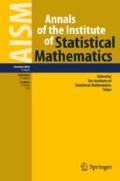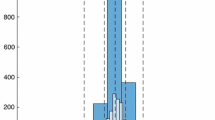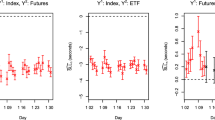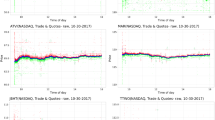Abstract
We develop a general class of noise-robust estimators based on the existing estimators in the non-noisy high-frequency data literature. The microstructure noise is a parametric function of the limit order book. The noise-robust estimators are constructed as plug-in versions of their counterparts, where we replace the efficient price, which is non-observable, by an estimator based on the raw price and limit order book data. We show that the technology can be applied to five leading examples where, depending on the problem, price possibly includes infinite jump activity and sampling times encompass asynchronicity and endogeneity.
Similar content being viewed by others
Notes
All the defined quantities are implicitly or explicitly indexed by n (except for the integrated parameter which does not depend on n). For example N should be thought and considered as \(N_n\). Consistency and convergence in law refer to the behavior as \(n \rightarrow \infty\). A full specification of the model also involves the stochastic basis \({{\mathcal {B}}}=(\Omega ,{\mathbb {P}},{{\mathcal {F}}},{\mathbf{F}})\), where \({{\mathcal {F}}}\) is a \(\sigma\)-field and \({\mathbf{F}}=({{\mathcal {F}}}_t)_{t\in [0,T]}\) is a filtration, which will be example-specific. We assume that all the processes (including the integrated parameter \(\xi _t\)) are \({\mathbf{F}}\)-adapted (either in a continuous or discrete meaning for \(Q_{t_i}\)) and that the observation times \(t_i\) are \({\mathbf{F}}\)-stopping times. Also, when referring to Itô-semimartingale and stable convergence in law, we automatically mean that the statement is relative to \({\mathbf{F}}\). Finally, we assume in (13) that W is also a Brownian motion under the larger filtration \({{\mathcal {H}}}_t = {{\mathcal {F}}}_t \vee \sigma \{Q_{t_i}, 0\le i\le N\}\).
Note that we do not assume that \(Q_t\) exists for any \(t \in [0,T] - \{t_0, \dots , t_N\}\) as it is often the case in the i.i.d setting, see, e.g., the framework in Jacod et al. (2009).
Here the restriction \(r < 1\) follows from Jacod and Rosenbaum (2013). Indeed, even for the realized volatility problem, (16) may not happen in the case \(r > 1\). Indeed, it yields a different optimal rate of convergence as shown in Jacod and Reiss (2014) (of the form \(N^\kappa {\text {log}}N\) for some \(\kappa >0\)). Moreover, as explained in their Remark 3.4, a CLT is not even achievable in some cases. The case \(r=1\) is let aside. Such bordercase is examined in Vetter (2010) when considering the bipower variation.
Remark 6 (p. 36) in Li et al. (2016) suggests that the threshold RV estimator can be used under endogeneity, but there is no formal proof and this is limited to the case of jumps with finite activity.
i.e. we assume that \(t_i\) are \({\mathbf {G}}\)-stopping times, where \({\mathbf {G}} =({{\mathcal {G}}}_t)_{t \in [0,T]}\) is a sub-filtration of \({\mathbf {F}}\) generated by finitely many Brownian motions, and that \(b_t\), \(\sigma _t\) and \(\delta\) are adapted to \({\mathbf {G}}\).
Here and in the other theorems, we mean that \(B_t\) is independent of the underlying \(\sigma\)-field \({\mathbf {F}}\).
Note that the definition of \({\widetilde{c}}_{i}\) slightly diverges from the previous section.
References
Aït-Sahalia, Y., Mykland, P. A., Zhang, L. (2005). How often to sample a continuous-time process in the presence of market microstructure noise. Review of Financial Studies, 18(2), 351–416.
Almgren, R., Chriss, N. (2001). Optimal execution of portfolio transactions. Journal of Risk, 3, 5–40.
Altmeyer, R., Bibinger, M. (2015). Functional stable limit theorems for quasi-efficient spectral covolatility estimators. Stochastic Processes and Their Applications, 125(12), 4556–4600.
Andersen, T. G., Bollerslev, T., Diebold, F. X., Ebens, H. (2001a). The distribution of realized stock return volatility. Journal of Financial Economics, 61(1), 43–76.
Andersen, T. G., Bollerslev, T., Diebold, F. X., Labys, P. (2001b). The distribution of realized exchange rate volatility. Journal of the American Statistical Association, 96(453), 42–55.
Andersen, T. G., Dobrev, D., Schaumburg, E. (2014). A robust neighborhood truncation approach to estimation of integrated quarticity. Econometric Theory, 30(1), 3–59.
Andersen, T. G., Cebiroglu, G., Hautsch, N. (2017). Volatility, information feedback and market microstructure noise: A tale of two regimes. Retrieved 9 May 2017. Working paper available at https://www.papersssrncom/sol3/paperscfm?abstract_id=2921097.
Andersen, T. G., Thyrsgaard, M., Todorov, V. (2019). Time-varying periodicity in intraday volatility. Journal of the American Statistical Association, 114(528), 1695–1707.
Barndorff-Nielsen, O. E., Shephard, N. (2002a). Econometric analysis of realized volatility and its use in estimating stochastic volatility models. Journal of the Royal Statistical Society Series B (Methodological), 64(2), 253–280.
Barndorff-Nielsen, O. E., Shephard, N. (2002b). Estimating quadratic variation using realized variance. Journal of Applied Econometrics, 17(5), 457–477.
Barndorff-Nielsen, O. E., Shephard, N. (2004). Power and bipower variation with stochastic volatility and jumps. Journal of Financial Econometrics, 2(1), 1–37.
Barndorff-Nielsen, O. E., Shephard, N. (2006). Econometrics of testing for jumps in financial economics using bipower variation. Journal of Financial Econometrics, 4(1), 1–30.
Barndorff-Nielsen, O. E., Graversen, S. E., Jacod, J., Podolskij, M., Shephard, N. (2006a). A central limit theorem for realised power and bipower variations of continuous semimartingales. From stochastic calculus to mathematical finance, pp. 33–68. Berlin: Springer.
Barndorff-Nielsen, O. E., Graversen, S. E., Jacod, J., Shephard, N. (2006b). Limit theorems for bipower variation in financial econometrics. Econometric Theory, 22(4), 677–719.
Barndorff-Nielsen, O. E., Shephard, N., Winkel, M. (2006c). Limit theorems for multipower variation in the presence of jumps. Stochastic Processes and Their Applications, 116(5), 796–806.
Barndorff-Nielsen, O. E., Hansen, P. R., Lunde, A., Shephard, N. (2008). Designing realized kernels to measure the ex post variation of equity prices in the presence of noise. Econometrica, 76(6), 1481–1536.
Bibinger, M., Vetter, M. (2015). Estimating the quadratic covariation of an asynchronously observed semimartingale with jumps. Annals of the Institute of Statistical Mathematics, 67(4), 707–743.
Black, F. (1986). Noise. The Journal of Finance, 41(3), 528–543.
Chaker, S. (2017). On high frequency estimation of the frictionless price: The use of observed liquidity variables. Journal of Econometrics, 201(1), 127–143.
Clinet, S., Potiron, Y. (2018). Efficient asymptotic variance reduction when estimating volatility in high frequency data. Journal of Econometrics, 206(1), 103–142.
Clinet, S., Potiron, Y. (2019a). Disentangling sources of high frequency market microstructure noise. Journal of Business & Economic Statistics, https://doi.org/10.1080/07350015.2019.1617158.
Clinet, S., Potiron, Y. (2019b). Testing if the market microstructure noise is fully explained by the informational content of some variables from the limit order book. Journal of Econometrics, 209(2), 289–337.
Cont, R., Kukanov, A., Stoikov, S. (2014). The price impact of order book events. Journal of Financial Econometrics, 12(1), 47–88.
Corsi, F., Pirino, D., Reno, R. (2010). Threshold bipower variation and the impact of jumps on volatility forecasting. Journal of Econometrics, 159(2), 276–288.
Diebold, F. X., Strasser, G. (2013). On the correlation structure of microstructure noise: A financial economic approach. The Review of Economic Studies, 80(4), 1304–1337.
Glosten, L. R., Harris, L. E. (1988). Estimating the components of the bid/ask spread. Journal of Financial Economics, 21(1), 123–142.
Hasbrouck, J. (1993). Assessing the quality of a security market: A new approach to transaction-cost measurement. The Review of Financial Studies, 6(1), 191–212.
Hasbrouck, J. (2002). Stalking the “efficient price” in market microstructure specifications: An overview. Journal of Financial Markets, 5(3), 329–339.
Hasbrouck, J. (2007). Empirical market microstructure: The institutions, economics, and econometrics of securities trading. New York: Oxford University Press.
Hayashi, T., Kusuoka, S. (2008). Consistent estimation of covariation under nonsynchronicity. Statistical Inference for Stochastic Processes, 11(1), 93–106.
Hayashi, T., Yoshida, N. (2005). On covariance estimation of non-synchronously observed diffusion processes. Bernoulli, 11(2), 359–379.
Hayashi, T., Yoshida, N. (2008). Asymptotic normality of a covariance estimator for nonsynchronously observed diffusion processes. Annals of the Institute of Statistical Mathematics, 60(2), 367–406.
Hayashi, T., Yoshida, N. (2011). Nonsynchronous covariation process and limit theorems. Stochastic Processes and Their Applications, 121(10), 2416–2454.
Jacod, J., Li, Y., Mykland, P. A., Podolskij, M., Vetter, M. (2009). Microstructure noise in the continuous case: The pre-averaging approach. Stochastic Processes and Their Applications, 119(7), 2249–2276.
Jacod, J., Podolskij, M., Vetter, M. (2010). Limit theorems for moving averages of discretized processes plus noise. Annals of Statistics, 38(3), 1478–1545.
Jacod, J., Protter, P. (1998). Asymptotic error distributions for the Euler method for stochastic differential equations. Annals of Probability, 26, 267–307.
Jacod, J., Protter, P. E. (2011). Discretization of processes. Berlin: Springer.
Jacod, J., Reiss, M. (2014). A remark on the rates of convergence for integrated volatility estimation in the presence of jumps. Annals of Statistics, 42(3), 1131–1144.
Jacod, J., Rosenbaum, M. (2013). Quarticity and other functionals of volatility: Efficient estimation. Annals of Statistics, 41(3), 1462–1484.
Kavajecz, K. A. (1999). A specialist’s quoted depth and the limit order book. The Journal of Finance, 54(2), 747–771.
Kinnebrock, S., Podolskij, M. (2008). A note on the central limit theorem for bipower variation of general functions. Stochastic Processes and Their Applications, 118(6), 1056–1070.
Koike, Y. (2014a). An estimator for the cumulative co-volatility of asynchronously observed semimartingales with jumps. Scandinavian Journal of Statistics, 41(2), 460–481.
Koike, Y. (2014b). Limit theorems for the pre-averaged Hayashi–Yoshida estimator with random sampling. Stochastic Processes and Their Applications, 124(8), 2699–2753.
Koike, Y. (2016). Estimation of integrated covariances in the simultaneous presence of nonsynchronicity, microstructure noise and jumps. Econometric Theory, 32(3), 533–611.
Li, Y., Zhang, Z., Zheng, X. (2013). Volatility inference in the presence of both endogenous time and microstructure noise. Stochastic Processes and Their Applications, 123(7), 2696–2727.
Li, Y., Mykland, P. A., Renault, E., Zhang, L., Zheng, X. (2014). Realized volatility when sampling times are possibly endogenous. Econometric Theory, 30(03), 580–605.
Li, Y., Xie, S., Zheng, X. (2016). Efficient estimation of integrated volatility incorporating trading information. Journal of Econometrics, 195(1), 33–50.
Madhavan, A. (2000). Market microstructure: A survey. Journal of Financial Markets, 3(3), 205–258.
Madhavan, A., Richardson, M., Roomans, M. (1997). Why do security prices change? A transaction-level analysis of NYSE stocks. The Review of Financial Studies, 10(4), 1035–1064.
Mancini, C. (2009). Non-parametric threshold estimation for models with stochastic diffusion coefficient and jumps. Scandinavian Journal of Statistics, 36(2), 270–296.
Mancini, C. (2011). The speed of convergence of the threshold estimator of integrated variance. Stochastic Processes and Their Applications, 121(4), 845–855.
Mancino, M. E., Sanfelici, S. (2012). Estimation of quarticity with high-frequency data. Quantitative Finance, 12(4), 607–622.
Martin, O., Vetter, M. (2020). The null hypothesis of (common) jumps in case of irregular and asynchronous observations. Scandinavian Journal of Statistics, 47(3), 711–756.
Meddahi, N. (2002). A theoretical comparison between integrated and realized volatility. Journal of Applied Econometrics, 17(5), 479–508.
Mykland, P. A., Zhang, L. (2006). ANOVA for diffusions and Ito processes. Annals of Statistics, 34(4), 1931–1963.
Mykland, P. A., Zhang, L. (2009). Inference for continuous semimartingales observed at high frequency. Econometrica, 77(5), 1403–1445.
Mykland, P. A., Zhang, L. (2012). The econometrics of high frequency data. In M. Kessler, A. Lindner, M. Sørensen (Eds.), Statistical methods for stochastic differential equations, pp. 109–190. Boca Raton, FL: Chapman and Hall/CRC Press.
Mykland, P. A., Shephard, N., Sheppard, K. (2012). Efficient and feasible inference for the components of financial variation using blocked multipower variation. Technical Report, University of Oxford, available at https://doi.org/10.2139/ssrn2008690.
O’hara, M. (1995). Market microstructure theory, Vol. 108. Cambridge, MA: Blackwell.
Potiron, Y., Mykland, P. A. (2016). Local parametric estimation in high frequency data. Working paper available at arXiv:160305700.
Potiron, Y., Mykland, P. A. (2017). Estimation of integrated quadratic covariation with endogenous sampling times. Journal of Econometrics, 197(1), 20–41.
Reiss, M. (2011). Asymptotic equivalence for inference on the volatility from noisy observations. Annals of Statistics, 39(2), 772–802.
Renault, E., Sarisoy, C., Werker, B. J. (2017). Efficient estimation of integrated volatility and related processes. Econometric Theory, 33(2), 439–478.
Robert, C. Y., Rosenbaum, M. (2010). A new approach for the dynamics of ultra-high-frequency data: The model with uncertainty zones. Journal of Financial Econometrics, 9(2), 344–366.
Robert, C. Y., Rosenbaum, M. (2012). Volatility and covariation estimation when microstructure noise and trading times are endogenous. Mathematical Finance, 22(1), 133–164.
Roll, R. (1984). A simple implicit measure of the effective bid-ask spread in an efficient market. The Journal of Finance, 39(4), 1127–1139.
Stoll, H. R. (2000). Presidential address: Friction. The Journal of Finance, 55(4), 1479–1514.
Vetter, M. (2010). Limit theorems for bipower variation of semimartingales. Stochastic Processes and Their Applications, 120(1), 22–38.
Vetter, M. (2015). Estimation of integrated volatility of volatility with applications to goodness-of-fit testing. Bernoulli, 21(4), 2393–2418.
Xiu, D. (2010). Quasi-maximum likelihood estimation of volatility with high frequency data. Journal of Econometrics, 159(1), 235–250.
Zhang, L. (2001). From martingales to ANOVA: Implied and realized volatility. PhD thesis, University of Chicago, Department of Statistics, Chicago.
Zhang, L. (2006). Efficient estimation of stochastic volatility using noisy observations: A multi-scale approach. Bernoulli, 12(6), 1019–1043.
Zhang, L., Mykland, P. A., Aït-Sahalia, Y. (2005). A tale of two time scales: Determining integrated volatility with noisy high-frequency data. Journal of the American Statistical Association, 100(472), 1394–1411.
Acknowledgements
We would like to thank Selma Chaker, Yingying Li, Xinghua Zheng, Manh Cuong Pham, Mathias Vetter, two anonymous referees, the participants of the 2nd International Conference on Econometrics and Statistics in Hong Kong, and the Econometric Society Australasian Meeting 2018 in Auckland for helpful discussions and advice. The research of Yoann Potiron is supported by a special private grant from Keio University and Japanese Society for the Promotion of Science Grant-in-Aid for Young Scientists No. 60781119. The research of Simon Clinet is supported by Japanese Society for the Promotion of Science Grant-in-Aid for Young Scientists No. 19K13671.
Author information
Authors and Affiliations
Corresponding author
Additional information
Publisher's Note
Springer Nature remains neutral with regard to jurisdictional claims in published maps and institutional affiliations.
Electronic supplementary material
Below is the link to the electronic supplementary material.
About this article
Cite this article
Clinet, S., Potiron, Y. Estimation for high-frequency data under parametric market microstructure noise. Ann Inst Stat Math 73, 649–669 (2021). https://doi.org/10.1007/s10463-020-00762-3
Received:
Revised:
Published:
Issue Date:
DOI: https://doi.org/10.1007/s10463-020-00762-3




